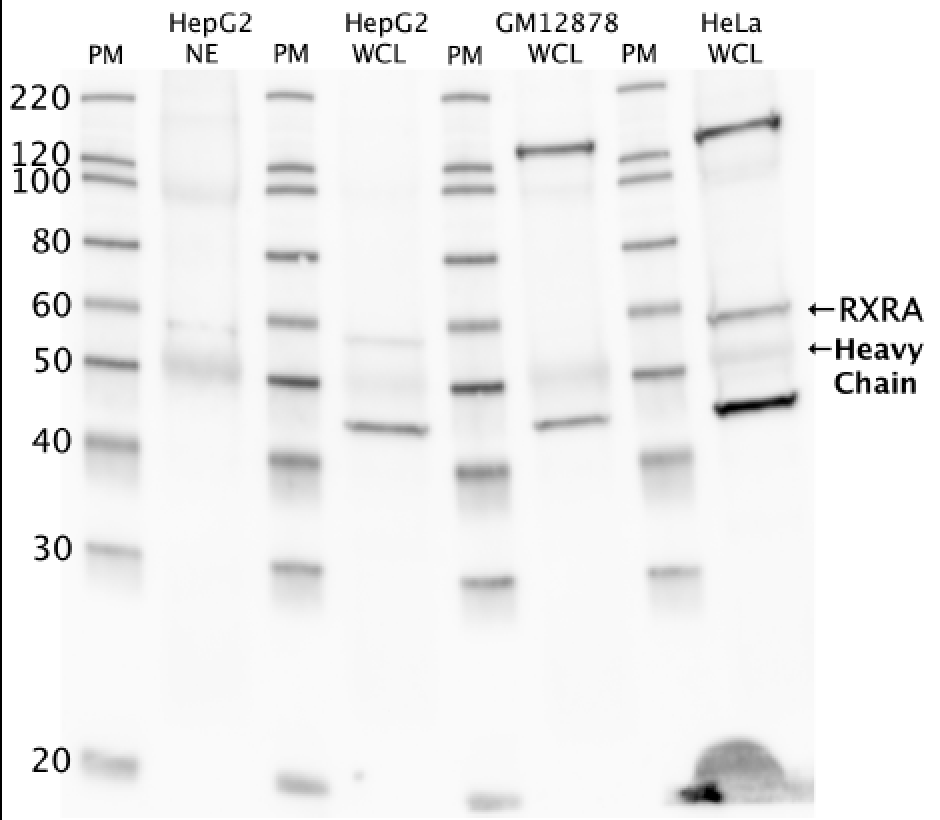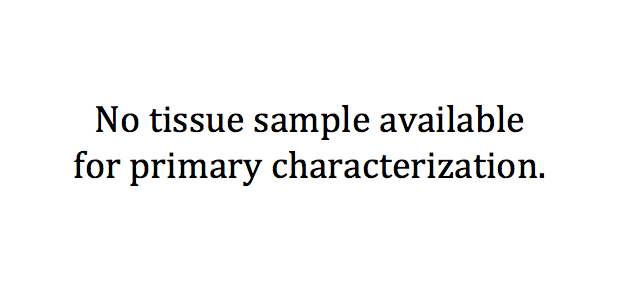ENCAB000AKN
Antibody against Homo sapiens RXRA
Homo sapiens
liver
characterized to standards with exemption
Homo sapiens
HepG2, GM12878, HeLa-S3
not characterized to standards
- Status
- released
- Source (vendor)
- Santa Cruz Biotech
- Product ID
- sc-553
- Lot ID
- C1811
- Characterized targets
- RXRA (Homo sapiens)
- Host
- rabbit
- Clonality
- polyclonal
- Purification
- affinity
- Antigen description
- Raised against a peptide mapping at the N-terminus of RXRalpha of human origin.
- External resources
Characterizations
RXRA (Homo sapiens)
Method: motif enrichment
compliant
- Caption
- The motif for target RXRA is represented by the attached position weight matrix (PWM) derived from ENCFF780ACW and ENCFF485WDP. Motif enrichment analysis was done by Dr. Zhizhuo Zhang (Broad Institute, Kellis Lab) using known motifs (http://compbio.mit.edu/encode-motifs/) and previously published ChIP-seq data (http://www.broadinstitute.org/~zzhang/motifpipeline/data/TrainSetInfo.txt). The accept probability score of the given transcription factor was calculated using a Bayesian approach. This analysis also includes three motif enrichment scores, computed by overlapping the motif instances with the given ChIP-seq peak locations. For more information on the underlying statistical methods, please see the attached document. From ENCFF780ACW Accept probability score: 0.997505759445, Global enrichment Z-score: 5.1718424384, Positional bias Z-score: 6.10971953644, Peak rank bias Z-score: 3.10586318664. From ENCFF485WDP: Accept probability score: 0.997450365755, Global enrichment Z-score: 5.04439037566, Positional bias Z-score: 6.10971953644, Peak rank bias Z-score: 3.105863186644, Enrichment rank: 1.0.
- Submitted by
- Aditi Narayanan
- Lab
- Richard Myers, HAIB
- Grant
- U54HG006998
- Download
- ENCAB000AKN.pdf
RXRA (Homo sapiens)
Method: immunoprecipitation followed by mass spectrometry
not reviewed
- Caption
- IP followed by mass spectrometry: Briefly, HeLa whole cell lysates were immunoprecipitated using primary antibody, and the IP fraction was loaded on a 12% acrylamide gel and separated with a Bio-Rad PROTEAN II xi system. Gel was stained with Coomassie Blue in order to visualize marker bands. Gel fragments corresponding to the bands indicated above in the western blot image were excised and sent to the University of Alabama at Birmingham Cancer Center Mass Spectrometry/Proteomics Shared Facility. There the samples were run on an LTQ XL Linear Ion Trap Mass Spectrometer by LC-ESI-MS/MS. Peptides were identified using SEQUEST tandem mass spectra analysis, with probability based matching at p < 0.05. As per ENCODE data standards, all SEQUEST results are attached (ENCODE_HAIB_RXRA_sc553_09122011_MassSpec.pdf), including common contaminants. Target protein is listed as hit 32 in the ~60 kDa band.
- Reviewer comment
- too much data to fit onto a screenshot -MHO
- Submitted by
- Richard Myers
- Lab
- Richard Myers, HAIB
- Grant
- U54HG004576
- Download
- human_RXRA_validation_Myers.pdf
- Documents
RXRA (Homo sapiens)
HepG2GM12878HeLa-S3
not compliant
- Caption
- Western blot protocol: Whole cell lysate was immunoprecipitated using primary antibody, and the IP fraction was loaded on a 12% acrylamide gel and separated with a Bio-Rad PROTEAN II xi system. After separation, the samples were transferred to a nitrocellulose membrane with an Invitrogen iBlot system. Blotting with primary (same as that used for IP) and secondary HRP-conjugated antibodies was performed on an Invitrogen BenchPro 4100 system. Visualization was achieved using SuperSignal West Femto solution (Thermo Scientific). Results: Band of expected size visualized, representing strongest signal in the lane. Figure legend: IP-western with sc-553 in nuclear extract (NE) of HepG2 and whole cell lysate (WCL) of HepG2, GM12878 and HeLa; PM=protein marker. RXRA bands are indicated.
- Reviewer comment
- Band of interest is not 50% of overall signal in lane
- Submitted by
- Richard Myers
- Lab
- Richard Myers, HAIB
- Grant
- U54HG004576
RXRA (Homo sapiens)
liver
exempt from standards
- Caption
- The ENCODE Binding Working Group finds for some valuable tissues that recreating a primary on well characterized antibodies is not cost effective. Therefore, they allow exemption from standards for these tissues.
- Submitter comment
- The lab is asking for an exemption for liver cells due to the lack of resource to make a primary characterization for them
- Reviewer comment
- Exempted by the Feb 29, 2016 antibody review panel
- Submitted by
- Richard Myers
- Lab
- Richard Myers, HAIB
- Grant
- U54HG006998
- Download
- No_tissue.png

